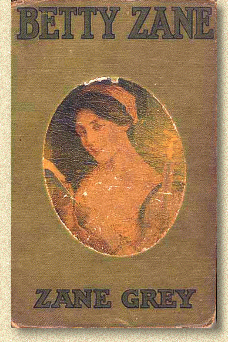by Marian Kester Coombs, ZGWS
One century ago, after rejections by several publishers, a dentist and former star pitcher named Pearl Zane Grey tapped his wife Dolly’s small inheritance to self-publish his first book. Betty Zane was a historical romance based upon his real-life Zane ancestors in the Wild West of 125 years earlier, the Ohio River Valley. Although no bestseller, the book did spark the long association between Zane Grey and Harper & Sons that was to justify every dollar and every iota of faith that Dolly invested in her husband.
Betty Zane tells the true story of a group of daring pioneer families who formed a leading edge of colonial America’s advancing western border, and participated there in the final engagement of the American Revolution — the defense of Fort Henry on September 11, 1782, near present-day Wheeling, West Virginia.

Betty Zane needs no introduction to millions throughout the United States, averred Grey’s Foreword in 1903. That is scarcely the case in these amnesiac times. Here, then, from the novel, is why Betty Zane is still honored by a plaque and statue in Wheeling:
That September the frontier fort came under siege by 200 British Rangers under Hamilton, various American renegades, and about 400 Shawnees. The defenders had run out of powder for their sole cannon and realized to their horror that the only resupply lay in a cabin some distance away. Betty, who could run like a deer, volunteered to make the desperate sortie.
Thinking she was merely a female trying to run away, the Indians taunted her as she dashed from the blockhouse to the cabin. Bursting in, Betty cried to the men there to empty a powder keg onto the tablecloth and sling it over her shoulder.
Like an arrow sprung from a bow Betty flashed past the Colonel and out on the green. Scarcely ten of the long hundred yards had been covered by her flying feet when a roar of angry shouts and yells warned Betty that the keen-eyed savages saw the bag of powder and now knew they had been deceived by a girl…
The leaden messengers of Death whistled past Betty. They sped before her and behind her, scattering pebbles in her path, striking up the dust, and ploughing little furrows in the ground. A quarter of the distance covered! Betty had passed the top of the knoll now and she was going down the gentle slope like the wind. None but a fine marksman could have hit that small, flitting figure. The yelling and screeching had become deafening. The reports of the rifles blended in a roar. … The bullets were raining about her. They sang over her head; hissed close to her ears, and cut the grass in front of her; they pattered like hail on the stockade fence, but still untouched, unharmed, the slender brown figure sped toward the gate.
Three fourths of the distance covered! A tug at the flying hair, and a long black tress cut off by a bullet floated away on the breeze. Betty saw the big gate swing; she saw the tall figure of the hunter; she saw her brother. On! On! On! A blinding red mist obscured her sight. She lost the opening in the fence but unheeding she rushed on. Another second and she stumbled; she felt herself grasped by eager arms; she heard the gate slam and the iron bar shot into place; then she felt and heard no more.
Young Elizabeth Zane survived. She had saved the fort’s inhabitants, and went on to be a foremother of Ohio Valley settlement as well as to appear in Grey’s next two books, The Spirit of the Border and The Last Trail. His self-taught writing style, already effective in Betty Zane, only improved with practice.
Thus Zane Grey began his career as America’s greatest Western author by chronicling his own family’s stirring role in the saga of America. Wherever he ranged thereafter, the same love for the people and land and story of this nation dominated his work, whether it dealt with Utah Mormons, Arizona deer-stalkers, Colorado desperados, wanderers of the wasteland, uprooted Navajos, Texas buffalo hunters, Nevada rustlers, or green Easterners blasted and reforged in the harsh vastness of the West.
Like most creative people, Grey was a bundle of contradictions — a man’s man, yet as sensitive as any Romantic poet to the beauties of nature and the fleeting shifts of feeling in a woman’s breast; a world-class fisherman and hunter, yet so fond of animals that many of his books dealt with dogs, horses and burros; a patriot and lover of all things American, yet repelled by the venality and fevered jingoism of the First World War.
So little record remains of the impression World War I made on the American psyche — almost as if the Spanish flu epidemic that followed in its wake had wiped out all memory of the event — that the following of Grey’s works are particularly valuable in trying to gauge how the country was changed by that social cataclysm: The Call of the Canyon, The Desert of Wheat, The Code of the West, 30,000 on the Hoof (now in print as Woman of the Frontier), The Vanishing American, and The Day of the Beast.
Grey, who died in 1939, would have had little use for the modern world, but we moderns could well use a hefty dose of him. Most of his Westerns are still available in paperback, either new or used.
ZGWS member Marian Kester Coombs lives in Crofton, Maryland, with her husband Fran, who is , currently a consultant for Rasmussen Reports. The Coombses have two grown daughters.